
Een overzicht van de kernwoorden over het verkeer. Hier kunt u gemakkelijk kernwoorden en definities opzoeken die u nog niet kent.
More subjects
The Aprilia RXV/SXV series are four-stroke, v-twin off road (RXV) or dual sport supermoto (SXV) motorcycles produced by Aprilia since 2006. Both versions have either 449 cc (27.4 cu in) or 549 cc (33.5 cu in) engine sizes. The RXV/SXV's frame is made of a combination of tubular steel and aluminum plates. The compact engine fits into the frame in such a way that the air filter sits on top of the engine, below the gas tank, rather than the more traditional under-the-seat location. This allows for a lower distribution of weight. (Source: Wikipedia.org, CC BY-SA)
BMW R100, with variant models designated by T, S, CS, RS, RS Classic, RT, RT Classic, TIC, TC, R and GS is a BMW motorcycle series, using a two-cylinder four-stroke boxer engine of 980 cc capacity. Model production began in 1976, with a premature shutdown and subsequent restart in 1985, and final completion of the series in 1996. The last of the 'airheads,' this article also discusses the different /7 models of smaller displacements (R60, R75, R80). (Source: Wikipedia.org, CC BY-SA)
The BMW R1200GS and R1200GS Adventure ('R1200GSA') are motorcycles manufactured in Berlin, Germany by BMW Motorrad, part of the BMW group. It is one of the BMW GS family of dual sport motorcycles. Both motorcycles have a 1,170 cc (71 cu in), two-cylinder boxer engine with four valves per cylinder. The Adventure has a large-capacity fuel tank and long travel suspension. As of 2012, BMW's R1200GS bikes are their top-selling models. (Source: Wikipedia.org, CC BY-SA)
The BMW R32 was the first motorcycle produced by BMW under the BMW name. An aircraft engine manufacturer during World War I, BMW was forced to diversify after the Treaty of Versailles banned the German air force and German aircraft manufacture. BMW initially turned to industrial engine design and manufacturing. (Source: Wikipedia.org, CC BY-SA)
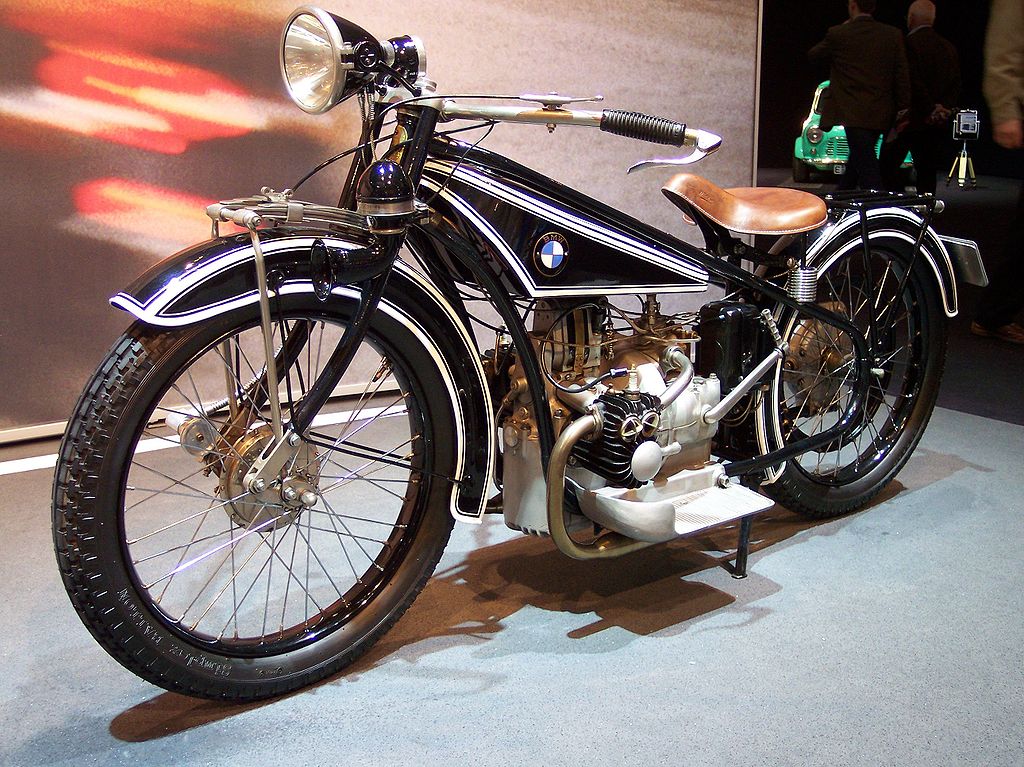 © Wikimedia.org/Stahlkocher, CC BY-SA
© Wikimedia.org/Stahlkocher, CC BY-SA
The BMW R60 and R60/2 are 600 cc boxer-twin that were manufactured from 1956 to 1969 in Munich, Germany, by BMW. Some 20,133 of these 600 cc shaft-drive, opposed twin R60 (1956–1960, 28 hp or 21 kW), R60/2 (1960–1969, 30 hp or 22 kW), and R60US (1968–1969, 30 hp) were built. These models, except for those with the 'US' designation, were designed primarily as rugged motorcycles to pull sidecars (mounting points were built in) and had duplex tubular steel frames. In the United States, all these Earles-fork and US-fork (i.e., telescopic fork) models from 1955 to 1969 are often lumped together as 'Slash-2' BMWs, even though that is technically incorrect. Not all of them, as seen above, have the '/2' designation. (Source: Wikipedia.org, CC BY-SA)
The BMW R 80 G/S is a motorcycle that was manufactured in Berlin, Germany, by BMW Motorrad from 1980 to 1987. Production totalled 21,864 bikes. It was the first in the BMW GS family of specialised dual-sport bikes, of which over 500,000 have been produced, and is often considered the world's first 'Adventure Bike' able to be equally capable on and off road. The designation G/S stands for the German words Gelände/Straße, which mean offroad/road – highlighting the bike's dual sport design. (Source: Wikipedia.org, CC BY-SA)
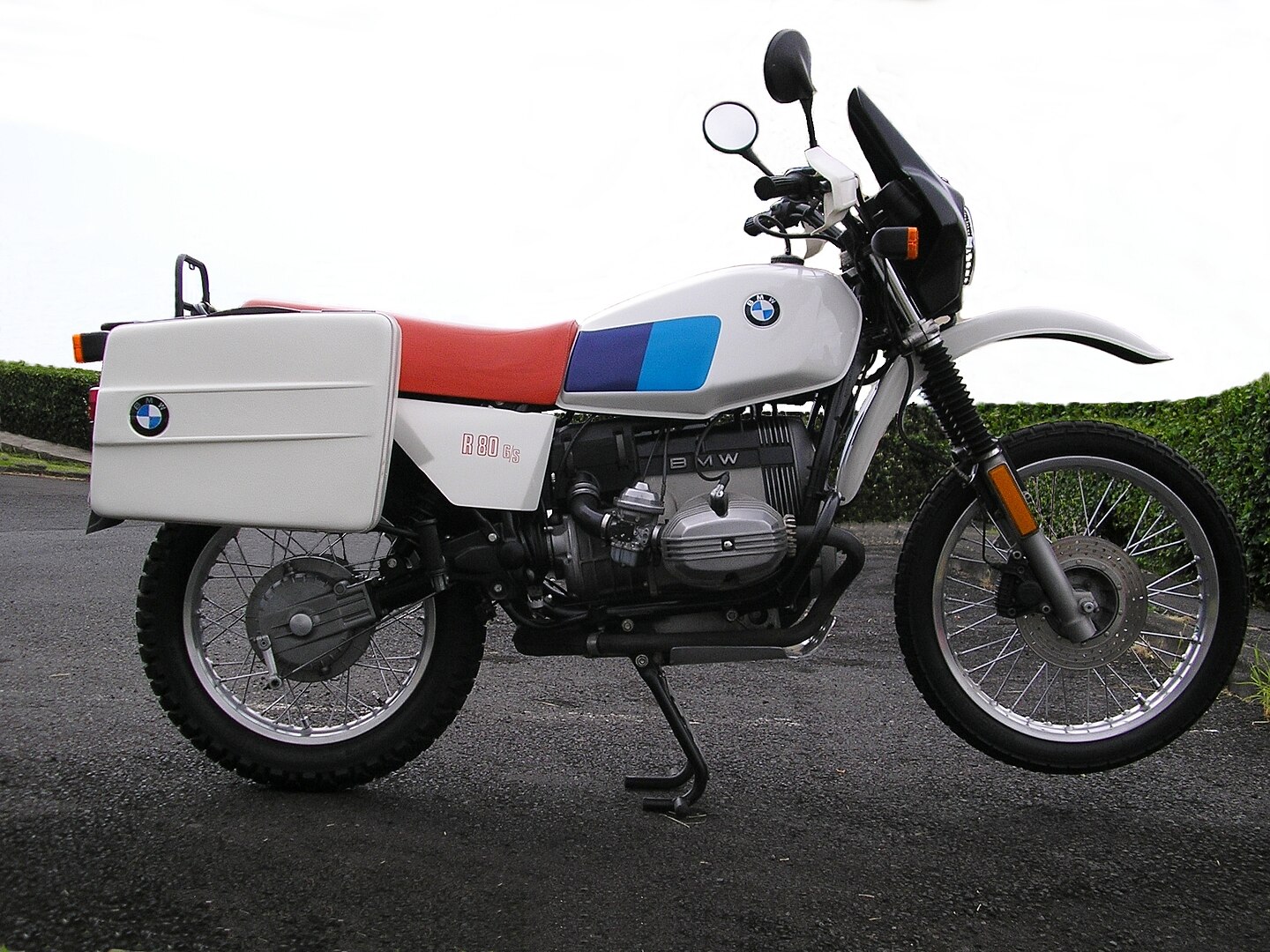 © Wikimedia.org/Gastair, CC0
© Wikimedia.org/Gastair, CC0
The BSA Gold Star is a motorcycle made by BSA from 1938 to 1963. They were 350 cc and 500 cc single-cylinder four-stroke production motorcycles known for being among the fastest bikes of the 1950s. Being hand built and with many optional performance modifications available, each motorcycle came from the factory with documented dynamometer test results, allowing the new owner to see the horsepower (bhp) produced. The Gold Star was almost continuously developed over its lifetime by BSA's engineers and riders, who improved its capabilities and increased output from its essentially simple[opinion] push-rod petrol engine than had been thought possible[by whom?]. It was highly successful across almost all areas of motorcycle sport for well over a decade and is still regarded as a design icon of its era. (Source: Wikipedia.org, CC BY-SA)
The Britten V1000 is a handbuilt race motorcycle designed and built by John Britten and a group of friends in Christchurch, New Zealand during the early 1990s. The bike went on to win the Battle of the Twins in Daytona International Speedway's Daytona Bike Week festivities in the United States and set several world speed records. The bike was designed from first principles and hosts a number of innovations including extensive use of carbon fibre, the radiator located under the seat, double wishbone front suspension, frameless chassis, and engine data logging. A total of 10 Britten V1000s were produced by the Britten Motorcycle Company and now exist in collections and museums around the world. (Source: Wikipedia.org, CC BY-SA)
The Ducati 750 Imola Desmo is a racing motorcycle built by Ducati that won the 1972 Imola 200 race in the hands of Paul Smart. This win helped define Ducati's approach to racing. On March 20, 1970, Fabio Taglioni (September 10, 1920 – July 18, 2001) made the first sketches for the layout of a new Ducati V-twin engine. By April his drawings were completed, and by July, there was a running motor. By August 1970, there was a complete prototype motorcycle. Taglioni engaged Leopoldo Tartarini, the founder of Italjet, to refine the styling aspects of the new Ducati. In October 1970, the decision was made by Ducati to re enter motorcycle competition. Director Arnaldo Milvio and General Manager Fredmano Spairani, were enthusiastic about racing, and had encouraged Fabio Taglioni to develop the 750 V twin. (Source: Wikipedia.org, CC BY-SA)
The Ducati 916 is a fully faired sport bike made by Ducati from 1994 to 1998. Featuring a 916 cc (56 cu in) fuel injected, 4-valve, desmo, liquid-cooled, 90° V-twin engine in a trellis frame with a single-sided swingarm and USD forks, the 916 is frequently cited as one of the motorcycles ever. The first development of the 916 model family can be traced back to the development of the four-valve Ducati engine, the Desmoquattro, through the development and racing of the earlier Pantah models, to the road-going 851 and 888 models. (Source: Wikipedia.org, CC BY-SA)
 © Wikimedia.org/ScuderiaAssindia, CC BY-SA
© Wikimedia.org/ScuderiaAssindia, CC BY-SA
The Ducati Desmosedici RR is a limited production road-legal version of the Desmosedici MotoGP racebike. In 2004, Ducati announced at the Misano circuit at the World Ducati Week that a low volume road replica of the Desmosedici would be available for reservations beginning in June 2006. With Ducati making 1,500 Desmosedici models for public purchase. Ducati first showed a final production version of the bike at a press day for the '06 Italian Grand Prix at Mugello. Termed the Desmosedici RR (Racing Replica), it was claimed to be the first true road replica of a MotoGP racing bike. Priority for ordering was given to Ducati 999R owners, with production projected at one bike per day at a retail cost of US$72,500 and £40,000. The price included a three-year warranty and servicing, cover, and a racing kit including a race-only exhaust system, a slip-on muffler, and complementary fuel and ignition mapping in a 'race ECU'. (Source: Wikipedia.org, CC BY-SA)
The Ducati Monster (called Il Mostro in Italian) is a standard, or naked bike, motorcycle designed by Miguel Angel Galluzzi and produced by Ducati in Bologna, Italy, since 1993. In 2005, Monster sales accounted for over half of Ducati's worldwide sales. Like most modern Ducati motorcycles, it has a 90° V-twin engine, called an L-twin by Ducati, with desmodromic valves, and tubular steel trellis frame, designed by Fabio Taglioni (1920–2001). (Source: Wikipedia.org, CC BY-SA)
The Ducati PaulSmart 1000 LE (PS1000LE) is a retro styled motorcycle built by Ducati in 2006 to commemorate Paul Smart's win at the Imola 200 race in 1972, a win that helped define Ducati's future approach to racing. The bike is styled in the fashion of the Ducati 750 Imola Desmo race bike that Paul Smart rode to victory, and the 1974 750 SuperSport it originally inspired. It is one of the SportClassic series designed by Pierre Terblanche. The bike is styled to look like a race bike from the 1970s, the rounded bubble style half fairing and café racer tail section are very reminiscent of the race winning 750 Imola Desmo. A green finished frame, outboard dampers and wire spoked rims with special Pirelli Phantom tires (featuring a retro tread pattern made exclusively for the PS1000LE) complete the look. (Source: Wikipedia.org, CC BY-SA)
 © Wikimedia.org/Livnay Associates, CC BY-SA
© Wikimedia.org/Livnay Associates, CC BY-SA
The Ducati Supersport and SS are a series of air-cooled four stroke desmodromic 2-valve 90° L-twin motorcycles made by Ducati since 1988. A limited edition Supersport called the SuperLight was sold in 1992. The name harked back to the round case 1973 Ducati 750 Super Sport, and the 1975 square case 750 and 900 Super Sport. The appellation 'SS' was applied only to the later belt drive (Pantah) based models. (Source: Wikipedia.org, CC BY-SA)
The FN Four was the world's first production inline-4 motorcycle, manufactured in Liége by Fabrique Nationale from 1905 until 1923. It was also, at 40 miles per hour (64 km/h), the world's fastest production motorcycle from 1911 until 1912. The motorcycle was developed in 1904, tested late that year, and had its public debut at the 1905 Paris Motorcycle Show. It was a commercial success upon release, with production increasing over its twenty-year run. (Source: Wikipedia.org, CC BY-SA)
Harley-Davidson FL is a model designation used for Harley-Davidson motorcycles since 1941, when F referred to the new large capacity 74 cui (1200cc) variant of the V-2 Overhead valve engine (″Knucklehead″) that was introduced in 1936 as Model E with 61 cui (1000cc). The presence of an additional letter L indicated higher compression, offering more power but requiring higher octane gasoline. In 1950s, the low compression version was discontinued, and in 1952 also the low capacity EL, making FL the standard engine and model designation for decades to come. (Source: Wikipedia.org, CC BY-SA)
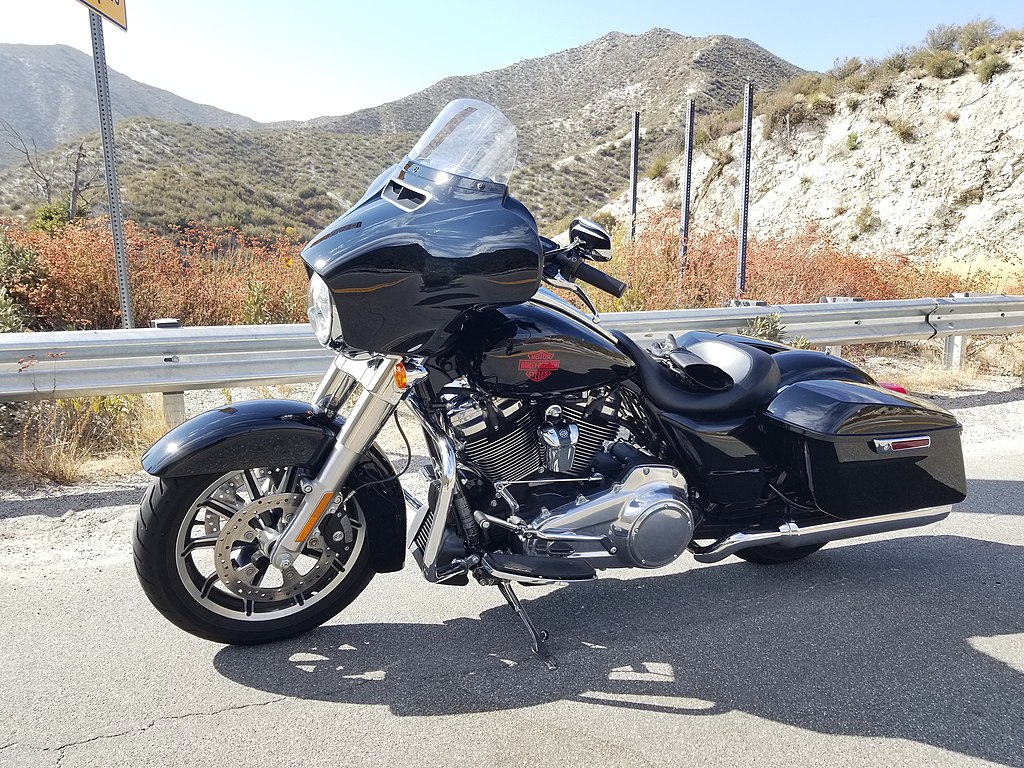 © Wikimedia.org/Callmeace, CC BY-SA
© Wikimedia.org/Callmeace, CC BY-SA
The Harley-Davidson Sportster is a line of motorcycles produced continuously since 1957 by Harley-Davidson. Sportster models are designated in Harley-Davidson's product code by beginning with 'XL'. In 1952, the predecessors to the Sportster, the Model K Sport and Sport Solo motorcycles, were introduced. These models K, KK, KH, and KHK of 1952 to 1956 had a sidevalve ('flat head') engine, whereas the later XL Sportster models use an overhead valve engine. The first Sportster in 1957 had many of the same details of the KH including the frame, fenders, large gas tank and front suspension. The original Sportster line was discontinued in Europe in 2020 because the engine failed to meet the stricter Euro 5 emissions standards. An all-new model, called the Sportster S and equipped with the Revolution Max engine, was introduced in 2021. It was the first motorcycle under the Sportster nameplate to receive a new engine since 1986, and the first Sportster to have an engine not derived from the Model K. (Source: Wikipedia.org, CC BY-SA)
The Harley-Davidson VRSC (V-twin racing street custom), or V-Rod, is a line of V-twin cruiser motorcycles made by Harley-Davidson from 1999 until 2017. They are often called muscle bikes for their relatively high power output. The V-Rods are the first street motorcycles made by Harley-Davidson with overhead camshafts and liquid cooling. The VRSC was introduced in 2001 in a single model called the V-Rod aiming to compete against Japanese and American muscle bikes. The V-Rod's Revolution engine was developed for road use by Porsche Engineering with the aid of a few Harley-Davidson engineers from Harley-Davidson's VR1000 V-twin racing bike engine. A derivative of the Revolution engine called the Revolution X was later used on the entry-level Harley-Davidson Street, first released in 2014. (Source: Wikipedia.org, CC BY-SA)
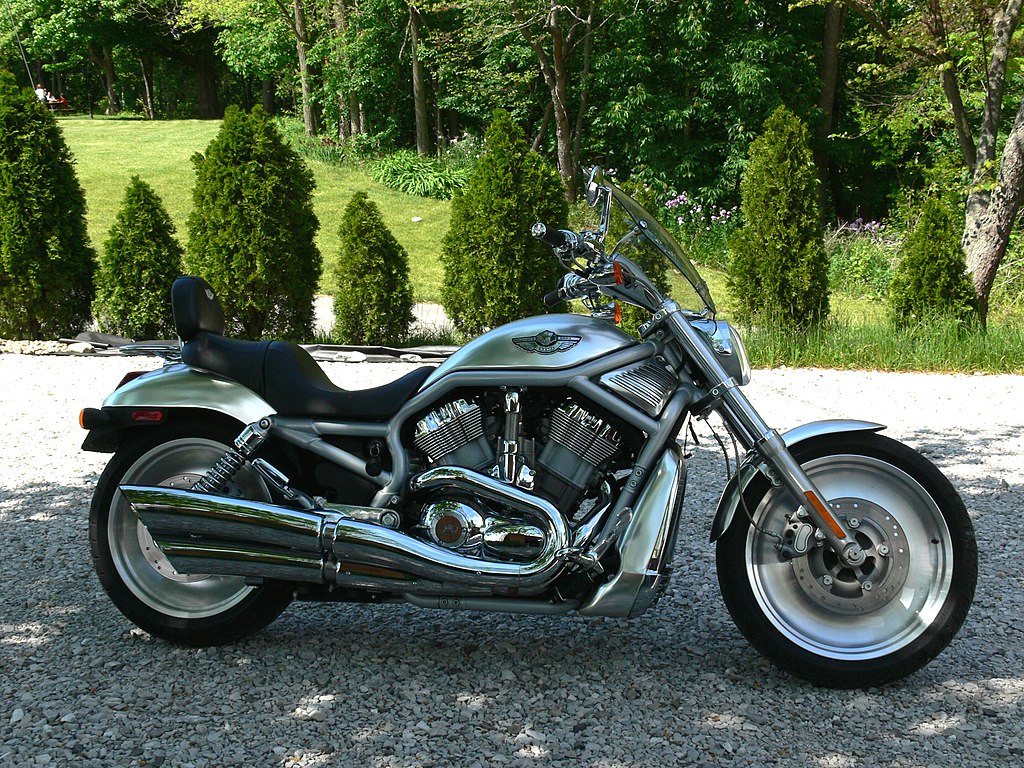 © Wikimedia.org, CC0
© Wikimedia.org, CC0
The Harley-Davidson XR-750 is a racing motorcycle made by Harley-Davidson since 1970, primarily for dirt track racing, but also for road racing in the XRTT variant. The XR-750 was designed in response to a 1969 change in AMA Grand National Championship rules that leveled the playing field for makes other than Harley-Davidson, allowing Japanese and British motorcycles to outperform the previously dominant Harley-Davidson KR race bike. The XR-750 went on to win the most races in the history of American Motorcyclist Association (AMA) racing. The XR-750 is associated with the careers of racers Mark Brelsford, Cal Rayborn, and Jay Springsteen, and was the favorite motorcycle of stunt performer Evel Knievel. Knievel used the bike from December 1970 until his final jump in January 1977. An XR-750 was included in the 1998 The Art of the Motorcycle exhibition, and one of Knievel's bikes is in the Smithsonian's National Museum of American History America on the Move exhibit. (Source: Wikipedia.org, CC BY-SA)
The Honda Africa Twin is a dual-sport motorcycle made by Honda in four versions, 1988 to 1989 as the 650 cc (40 cu in) V-twin XRV650, then from 1990 to 2000 as the 750 cc (46 cu in) V-twin XRV750T, then from 2016 to 2019 as the 1,000 cc (61 cu in) parallel-twin CRF1000L and from 2020 to present as the CRF1100L. The Africa Twin, also known as the Honda XRV750, is a 742 cc dual-sport motorcycle manufactured by Honda. The motorcycle was based on the NXR-750 which won the Paris-Dakar rally four times in the late eighties. It was preceded by the eponymous XRV650 Africa Twin which was a lighter, higher specification version made in 1988 and 1989 by Honda Racing Corporation with a 650 cc engine producing 42 kW (56 hp). The much earlier Honda XLV750R was a shaft driven motorcycle. (Source: Wikipedia.org, CC BY-SA)
The Honda CB750 is an air-cooled, transverse, in-line-four-cylinder-engine motorcycle made by Honda over several generations for year models 1969–2003, plus 2007, with an upright, or standard, riding posture. It is often called the original Universal Japanese Motorcycle (UJM). The CR750 is the associated works racer. Though other manufacturers had marketed the transverse, overhead camshaft, inline four-cylinder engine configuration and the layout had been used in racing engines prior to World War II, Honda popularized the configuration with the CB750, and the layout subsequently became the dominant sport bike engine layout. The CB750 is included in the AMA Motorcycle Hall of Fame Classic Bikes; was named in the Discovery Channel's 'Greatest Motorbikes Ever'; was in The Art of the Motorcycle exhibition, and is in the UK National Motor Museum. The Society of Automotive Engineers of Japan, Inc. rates the 1969 CB750 as one of the 240 Landmarks of Japanese Automotive Technology. The CB750 was the first motorcycle to be called a 'superbike'. (Source: Wikipedia.org, CC BY-SA)
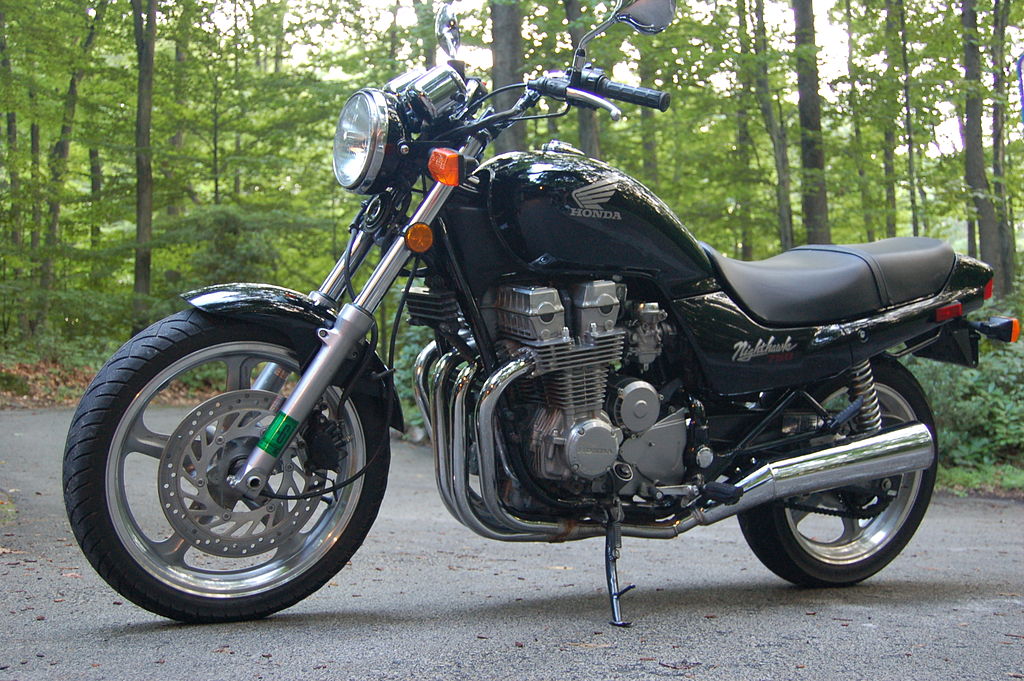 © Wikimedia.org/Dayvroy, CC BY-SA
© Wikimedia.org/Dayvroy, CC BY-SA
The Honda CB77, or Super Hawk, is a 305 cc (18.6 cu in) straight-twin motorcycle produced from 1961 until 1967. It is remembered today as Honda's first sport bike. It is a landmark model in Honda's advances in Western motorcycle markets of the 1960s, noted for its speed and power as well as its reliability, and is regarded as one of the bikes that set the standard for modern motorcycles. The CB77 had, at only 305 cc, a relatively big engine in comparison to most other Japanese bikes of the period, although it had performance to rival much larger motorcycles from other countries. It quickly built a reputation for reliability, and was equipped with luxuries such as an electric starter. (Source: Wikipedia.org, CC BY-SA)
The Honda CBR600F is a CBR series 600 cubic centimetres (36.6 cubic inches) inline four-cylinder sport bike motorcycle made by Honda Motorcycles. The first model of the CBR600F was sold from 1987 to 1990 and is known in the US as the Hurricane. In Austria and Mexico, a smaller version, called CBR500F, was offered. The subsequent models are designated as CBR600F2, F3, F4, and F4i respectively. In 2011, Honda released a more modern model with the same name. The original CBR600F, along with the CBR750F and CBR1000F were Honda's first inline four-cylinder, fully-faired sport bikes. The style was said to be influenced by a brief European trend toward a smooth and completely enclosed fairing such as in the Ducati Paso. (Source: Wikipedia.org, CC BY-SA)
The Honda CBR900RR, or FireBlade in some countries, is a 900 cc (55 cu in) sport bike, part of the CBR series introduced in 1992 by Honda. It was the first of a series of large-displacement Honda models to carry the RR suffix. The development of the first generation CBR900RR was led by Tadao Baba. The first generation CBR900RR was introduced in 1992 with an 893 cc (54.5 cu in) inline-four engine. It set a precedent for lightweight in the superbike class, being much lighter than other large-displacement bikes of the time. The CBR900RR was based on an advanced research stage model known within Honda as the 'CBR750RR'. With the objective of equaling the acceleration of competitors’ flagship sport bikes, Honda increased the stroke of its inline 4-cylinder 750 cc engine and thus raised displacement to 893cc. Complementing its power performance was the bike's dry weight of just 185 kg, wheelbase of 1,405 mm, and a body almost identical to that of the advanced research stage model. At 205 kg (453 lb) wet weight, it was by just 1.8 kg (4 lb) heavier than the CBR600F2, while the next-lightest over-750cc machine, the Yamaha FZR1000, was heavier by 34 kg (76 lb). (Source: Wikipedia.org, CC BY-SA)
The Honda Gold Wing is a series of touring motorcycles manufactured by Honda. Gold Wings feature shaft drive and a flat engine. Characterized by press in September 1974 as 'The world's biggest motor cycle manufacturer's first attack on the over-750cc capacity market...', it was introduced at the Cologne Motorcycle Show in October 1974. Total sales are more than 640,000, most of them in the U.S. market. Gold Wings were assembled in Marysville, Ohio, from 1980 until 2010, when motorcycle production there was halted. No Gold Wings were produced for the 2011 model year, and production resumed in Kumamoto Prefecture, Japan in 2011 using tooling transported from the American factory. (Source: Wikipedia.org, CC BY-SA)
 © Wikimedia.org/Hubbaz, CC BY-SA
© Wikimedia.org/Hubbaz, CC BY-SA
The Honda NR (New Racing) was a V-four motorcycle series started by Honda in 1979 with the 500cc NR500 Grand Prix racer that used oval pistons. This was followed during the 1980s by a 750cc endurance racer version known as the NR750. The oval piston concept allowed for eight valves per cylinder which generated more power due to the increased air/fuel mixture and throughout compression. In 1992 Honda produced around 300 street versions of a 750cc model, the NR (often mistakenly referred to as the NR750), with a 90-degree V angle. Whereas the NR500 had used an oval piston with straight sides, the road going NR750 used an elliptical piston with curved long sides. The bike became the most expensive production bike at the time when it was selling for $50,000 and with the rarity, nowadays they rarely change hands. (Source: Wikipedia.org, CC BY-SA)
The Honda NSR500 is a road racing motorcycle created by HRC (Honda Racing Corporation) and debuted in 1984 for the Grand Prix motorcycle racing's 500 cc class. Honda won ten 500cc World Championships with the NSR500 from 1984 to 2002, with six in a row from 1994 to 1999. With more than 100 wins to its credit, the NSR500 is the most dominant force in modern Grand Prix motorcycle racing. The 1989 NSR500 that won Honda's third 500 World Championship with Eddie Lawson exemplifies the overwhelming power, acceleration and raw speed that has always been synonymous with Honda's 500 cc two-stroke V4. (Source: Wikipedia.org, CC BY-SA)
The Honda Shadow refers to a family of cruiser-type motorcycles made by Honda since 1983. The Shadow line features motorcycles with a liquid-cooled 45 or 52-degree V-twin engine ranging from 125 to 1,100 cc engine displacement. The 250 cc Honda Rebel is associated with the Shadow line in certain[example needed] markets. In 1983, Honda introduced the Shadow series of motorcycles in an attempt to address the needs of the American cruiser market with the VT500c and VT750c. However, due to tariff restrictions in the United States on imported Japanese bikes over 701 cc, the VT750c was reduced to 700 cc in 1984 and was sold as the Vt700c. In 1985, the tariff was lifted and the line soon expanded to an 1,100 cc bike the VT1100c. The VT750c was replaced by an 800 cc version the VT800c in 1988. (Source: Wikipedia.org, CC BY-SA)
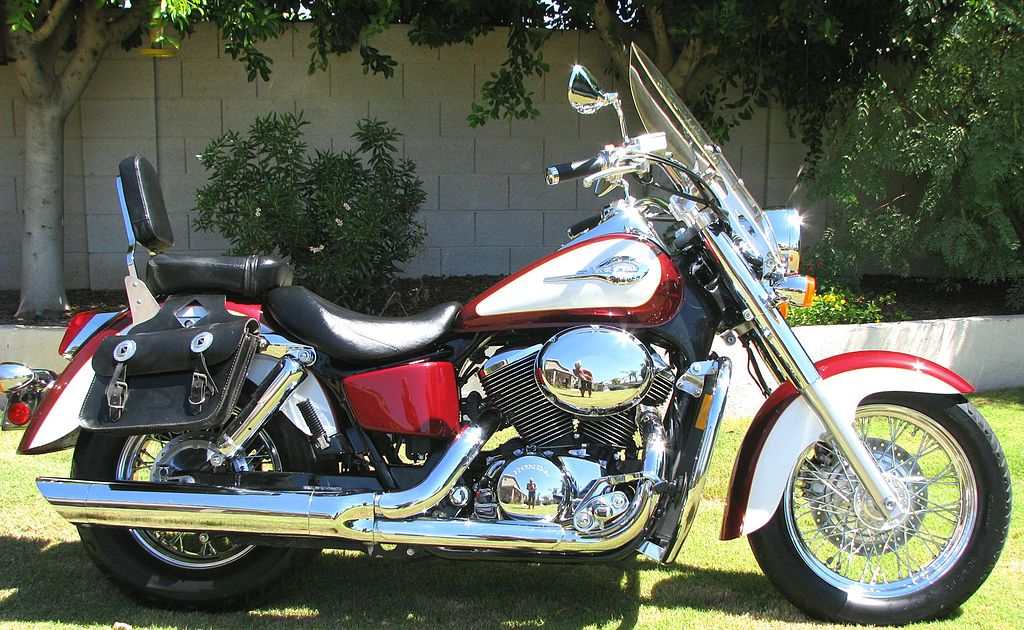 © Wikimedia.org, CC0
© Wikimedia.org, CC0
The Honda Super Cub or Honda Cub is a Honda underbone motorcycle with a four-stroke single-cylinder engine ranging in displacement from 49 to 124 cc (3.0 to 7.6 cu in). In continuous manufacture since 1958 with production surpassing 60 million in 2008, 87 million in 2014, and 100 million in 2017, the Super Cub is the most produced motor vehicle* in history. Variants include the C50, C65, C70 (including the Passport), C90, C100 (including the EX), and the Honda Trail series. The Super Cub's US advertising campaign, You meet the nicest people on a Honda, had a lasting impact on Honda's image and on American attitudes to motorcycling, and is often used as a marketing case study. (Source: Wikipedia.org, CC BY-SA)
The Honda VFR750F is a motorcycle manufactured by Japanese automobile manufacturer Honda from 1986 to 1997. The model was initially displayed to the press after the 1985 Bol d'Or before it was officially introduced in 1986. The motorcycle is a variation of sport bike and sport touring. The motorcycle is powered by a 750 cc (46 cu in) V4 engine that was developed from the VF700/750F models. The motorcycle's design is an evolution and complete redesign of the VF700/750F models. This redesign included multiple new features, including greater power output (104 hp up from 83 hp), lighter weight (claimed down 20 kg), a lower center of gravity, a wider front tire, a slightly shorter wheelbase (15mm), six gear ratios instead of five, and gear driven cams. (Source: Wikipedia.org, CC BY-SA)
 © Wikimedia.org/Heineken, CC BY-SA
© Wikimedia.org/Heineken, CC BY-SA
The Honda Valkyrie is a motorcycle that was manufactured by Honda from 1997 to 2003. It was designated GL1500C in the US market and F6C ('Flat Six Custom') in other markets. Back in the 90's there was a resurgence of interest in cruiser motorcycles, that generally feature a V-twin engine. The idea of an American cruiser styled motorcycle featuring a flat six engine came from Josef Boyd. The Valkyrie engine is a 1,520 cubic centimetres (93 cu in) liquid-cooled, horizontally opposed flat-six engine shared with Honda's Gold Wing model, unlike the V-twin engine commonly found on 'cruiser' style motorcycles. In its transplant from the Goldwing, the most notable engine changes were the camshaft and the change to six individual 28 mm carburetors, one for each cylinder, changes which increased power and torque. The Valkyrie was offered with a reverse gear in Japan. The Valkyrie was made in the United States at the Honda motorcycle plant in Marysville, Ohio. (Source: Wikipedia.org, CC BY-SA)
The Honda Z50A is a small motorcycle with a 49 cc (3.0 cu in) single-cylinder four-stroke overhead cam engine and a semi-automatic transmission. It was made by Honda from 1968 to 1978 and it was the second generation of the Z50 Series of minibikes. The 1968-1971 Z50As were known as the 'Hard Tail' because of their lack of rear shock absorbers. 1968 was also called a K0, a 1969-1970 is called a K1 and a 1970-71 are referred to as K2s. Rear shock absorbers were added to the Z50A in 1972 and it was referred to as a K3. (Source: Wikipedia.org, CC BY-SA)
The Indian Chief is a motorcycle that was built by the Hendee Manufacturing Company and the subsequent Indian Motocycle Company from 1922 to the end of the company's production in 1953, and again from 1999 to present.The Chief was Indian's 'big twin', a larger, more powerful motorcycle than the more agile Scout used in competition and sport riding. When Indian resumed civilian production after World War II, they revived only the Chief line. Production of Indian motorcycles ended with the last Chief made in 1953, then resumed again in 1999. (Source: Wikipedia.org, CC BY-SA)
The KTM 950 Adventure is a Dual-sport motorcycle produced in Austria by KTM. The bike is powered by a liquid cooled, four-stroke, DOHC 942 cc 75° V-twin engine, producing around 102 bhp (76 kW). The story of KTM 950 Adventure started in 1992. That year, a one-off special called the Bepono, built for the German BoTT series by two engineering students by combining a pair of cylinders from a KTM LC4 single on a special crankcase, was displayed on the KTM stand at the IFMA Show in Cologne. Although, this was just a teaser. The second time around in 1996, the Stuttgart-based design office Kraft Technik, commissioned by KTM to produce a design for a V-twin Hard Enduro, possibly using the 60-degree V-twin RSV900 Rotax engine they were developing for Aprilia. Unfortunately, the Italians refused to share it with their Austrian neighbors. An alternative was the Swedish Folan 60-degree V-twin engine, however that co-venture was aborted after KTM was successful on the stock market. (Source: Wikipedia.org, CC BY-SA)
The Kawasaki Ninja H2 is a 'supercharged supersport'-class motorcycle in the Ninja sports bike series manufactured by Kawasaki, featuring a variable-speed centrifugal supercharger. Its namesake is the 750 cc Kawasaki H2 Mach IV, an inline triple that was introduced by Kawasaki in 1972 to 'disrupt what it saw as a sleeping motorcycle market'. The Ninja H2R is a motorcycle track-only 310 horsepower (230 kW) and 326 horsepower (243 kW) with ram-air. The H2R has 50% more power than the fastest street-legal motorcycles,[which?] while the street-legal Ninja H2 has a lower power output of 200 hp (150 kW)–210 hp (160 kW) with ram-air. (Source: Wikipedia.org, CC BY-SA)
The Kawasaki Z1 is a four-cylinder, air-cooled, double-overhead camshaft, carbureted, chain-drive motorcycle introduced in 1972 by Kawasaki. Following the introduction of Honda's CB750 in 1968, the Z1 helped popularize the in-line, across-the-frame four-cylinder, a format that became known as the Universal Japanese Motorcycle or UJM. The Z1 was noted for being the first large-capacity Japanese four-cylinder motorcycle to use the double-overhead-camshaft system on a production motorcycle. When it was introduced, only the MV Agusta 750 S used this system; it was a very expensive limited-production machine, as opposed to the Kawasaki which was less than half the price. Marketed variously as the Z1-900, 900 Z1 or 900 S4 ('Super Four'), the Z1 was the first of Kawasaki's Z models. (Source: Wikipedia.org, CC BY-SA)
 © Wikimedia.org/Manju, CC BY-SA
© Wikimedia.org/Manju, CC BY-SA
The Kawasaki triples were a range of 250 to 750 cc (15 to 46 cu in) motorcycles made by Kawasaki from 1968 to 1980. The engines were air-cooled, three-cylinder, piston-controlled inlet port two-strokes with two exhaust pipes exiting on the right side of the bike, and one on the left. It was the first production street motorcycle with capacitor discharge ignition (CDI). Right from the first triple model, the 1968 Mach III H1 500 cc, it was a sales success that gained a reputation for almost unmatched acceleration as well as an air of danger for inexperienced riders trying to cope with the bike's increased power to weight ratio over any previously available stock motorcycles. (Source: Wikipedia.org, CC BY-SA)
The MV Agusta 750 S also known as the MV Agusta 750 Sport, was a motorcycle manufactured by the MV Agusta company from 1970 to 1975. Production total of this model series was 583 machines. The previous model, the MV Agusta 600, was designed as a touring machine but was not a great success. Its replacement, the 750 S, was designed as a sport bike, reflecting the racing heritage of the company. The four-cylinder engine had its capacity expanded to 750cc by increasing the bore, the exhaust system was upgraded and the seat, tank and handlebars were changed to more sporting items. (Source: Wikipedia.org, CC BY-SA)
The Moto Guzzi Le Mans is a sports motorcycle first manufactured in 1976 by Italian company Moto Guzzi. It was named after the 24-hour motorcycle endurance race at Le Mans in France. The Le Mans designation was first used for an 850 prototype, based on the V7, displayed at Premio Varrone in late 1972. The original 850 Le Mans was a café racer with clip-on handlebars and a bikini nose fairing, but in the face of more and more powerful bikes from other manufacturers later models were developed more as sports tourers with a three-quarter fairing. A marketing success, the Le Mans competed against Italian superbikes from Ducati and Laverda. The original Le Mans was continually developed and spawned several later models, a final versions appearing in the early 1990s. (Source: Wikipedia.org, CC BY-SA)
The Norton Commando is a British Norton-Villiers motorcycle with an OHV pre-unit parallel-twin engine, produced by the Norton Motorcycle company from 1967 until 1977. Initially having a nominal 750 cc displacement, actually 745 cc (45.5 cu in), in 1973 it became an 850 cc, actually 828 cc (50.5 cu in). It had a hemi-type head, similar to all OHV Norton engines since the early 1920s. During its ten years of production, the Commando was popular all over the world. In the United Kingdom it won the Motor Cycle News 'Machine of the Year' award for five successive years from 1968 to 1972. Around 60,000 Commandos were made in total. (Source: Wikipedia.org, CC BY-SA)
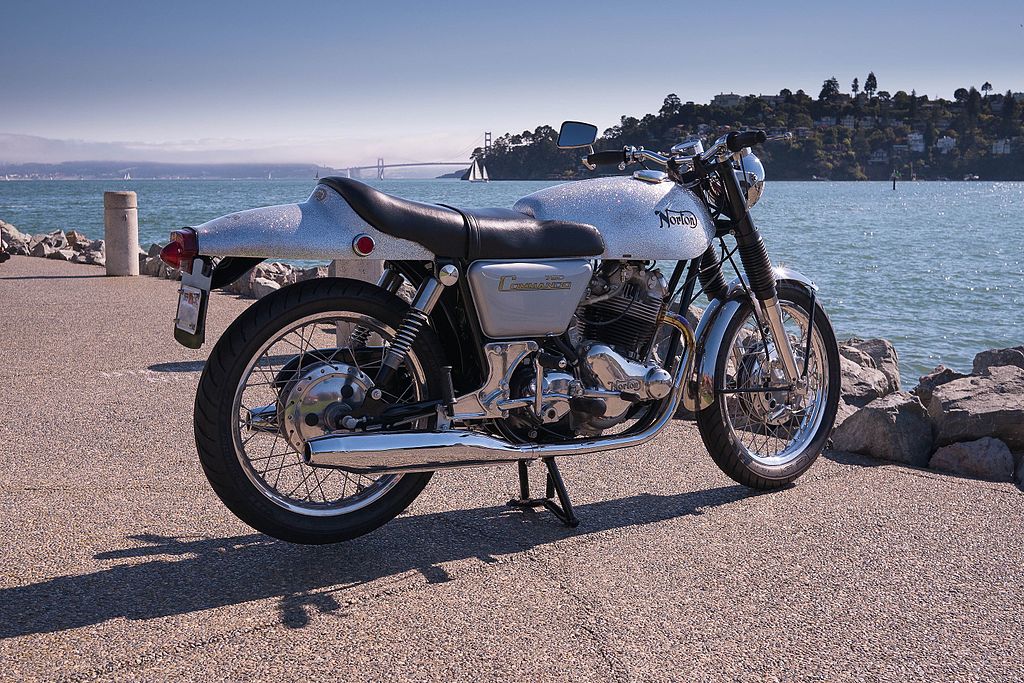 © Wikimedia.org/Jamescowdery, CC BY-SA
© Wikimedia.org/Jamescowdery, CC BY-SA

Time for recess! Post a comment, ask a question or write a review. Feel free to let us know what you think!
Heeft opzich wel goede oefeningen maar zou aanraden om ook op andere websites (gratis) te oefenen om een goed examen af te leggen
Ik heb 15 keer 50/50 gehaald op deze site ik ga naar het examencentrum en haal een 39
bij oefenexamen 1 zegt dat ik de gevarendriehoek op 50m moet plaatsen en bij 2 op 100m??
Vwb borden verkeersplein en rotonde slaat U hier de plank behoorlijk mis. Mag wel eens aangepast worden. Jammer.
Het zou handig zijn als jullie het op tyd laten gaan zoals op het examen. Groetjes David
ABS Nedir Nasıl Çalışır ? - https://www.diskfren.com/abs-nedir-nasil-calisir.html
Driving whit a tractor possible? What are the requirements? Can i drive whit a dutch T-licence?
het proefexamen op deze website is niet gedetailleerd genoeg waardoor de kennis volgens mij niet voldoende getest wordt, ik heb op meer dan 5 websites een proefexamen gemaakt en deze is zeer slecht. Gebruik aub de gratis website die de overheid heeft voorzien https://www.mijnrijbewijsb.be/, je zal zien dat de examens hier in ieder geval op deze website in veel groter detail gaan. (ik heb hier niets gekocht, enkel het gratis proefexamen gedaan)
Hallo,ik ben op de autokeuring geweigerd geweest omdat mijn rechter achtermistlicht gebroken is. Daar dit onderdeel tijdelijk onbeschikbaar is,heb ik dit hersteld met kleefband.De mistlichten werken nu allebij en ze hebben de goede rode kleur en toch ben ik opnieuw gewijgerd.hadden zij het recht mij hiervoor opnieuw te wijgeren?Zoja op welke basis? Dank u bij voorbaat.
Is de GPS verplicht in Antwerpen voor een examen praktische te gaan laten officiële doen categorie B bedankt
is er iemand die zijn examen al heeft gedaan en kan confirmeren dat dit hoe de test is
Amaai, wat moet dit moeilijk zijn voor een 17 jarige! Wel zeer leerzaam. Bedankt!